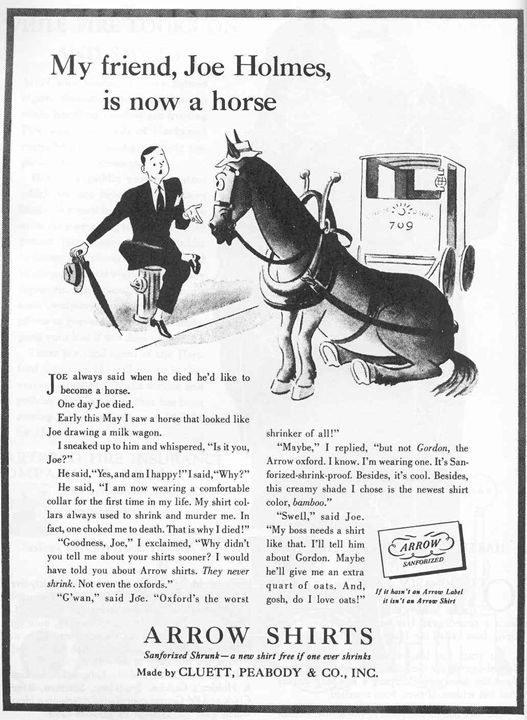100 Days of Leo Burnett, the Midwestern Master of Mascots DAY 75
Here’s today’s Leo:
“It seems axiomatic that you have to make a friend before you can effectively make him a proposition.” — Leo Burnett
Wow, 75 Leos to date! That’s 2.5 months of Leos — and we’re still going strong. This series will wrap up in mid-June, and then we’ll start up on Bill Bernbach. That’s going to be a blast.
One of my favorite — and earliest — advertising books is The 100 Greatest Advertisements 1852-1958: Who Wrote Them and What They Did by Julian Watkins. It was one of my first introductions to advertising history and it was an amazing educator. I still flip through it on a monthly basis for inspiration and reminders.
One of my favorite ads from that book — because I can *never* get it out of my mind — is from Arrow Shirts and it’s called “My Best Friend, Joe Holmes, is Now a Horse”. It was penned by the late, great George Gribbin of Y&R fame (my Dad briefly worked alongside George in the early ’60s). It’s rated #98 in the Advertising Age list of Top 100 ads.

One thing you’ll notice when you study The 100 Greatest Advertisements 1852-1958: Who Wrote Them and What They Did is the high art of copywriting in the Direct Era period of the business (which is basically all the book covers — it’s pre-Mass Era). Some of it is poetic … all of it tells great stories. I’m finding it pretty amusing in our new Direct-Mass Era how people are suddenly “discovering” the importance of storytelling. I don’t want to burst anyone’s bubble … but srsly, they figured this out a long time ago. Just because we forgot the lesson … and then discovered it again … doesn’t make us geniuses. It makes us children.
If you’re really serious about storytelling, you should read Story: Substance, Structure, Style and the Principles of Screenwriting by Robert McKee. And if you ever have a chance to attend a Robert McKee Seminar … GO. I attended one in NYC a few years ago and it was life changing … it took story concepts which I loosely understood on an instinctive level and helped me express them in programmatic terms.
Your story starts in stasis … everything is normal. Then, an inciting incident occurs, and the stasis is interrupted. The journey of the protagonist is to overcome obstacles in order to return to stasis or a new normal. Think about all the great stories you’ve ever read or seen — they all follow this arc. The drama comes from the journey — how will the hero overcome this next obstacle to accomplish the task? The movie Gravity is a textbook example of this structure: It’s another day in NASA … everything blows up … Sandra Bullock overcomes one crazy obstacle after another to survive … it’s another day in NASA (but now on earth). Try it sometime with your favorite book or movie … and then use it in conversation. You’ll notice people are riveted to your words.
#madmen #advertising @LeoBurnett #LeoBurnett #Y&R #ArrowShirts #RobertMcKee

